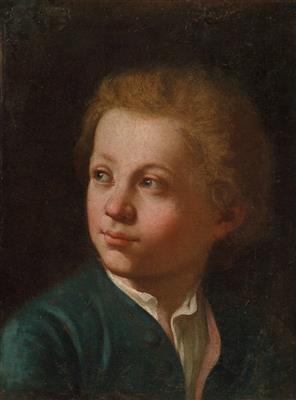Pietro Antonio Rotari

(Verona 1707–1762 St. Petersburg)
Portrait of a boy,
oil on canvas, 38.5 x 28.9 cm, framed
Inscribed on an old label on the reverse: Ritratto […] / di Paolo […] / Lucrezia
Provenance:
from the family of the artist and by descent to the present owner
Literature:
S. Marinelli, Le due vite di Pietro Rotari, in: Verona illustrata, 2010, 168.2010, p. 113, fig. 94
The present Portrait of a boy has been dated by Sergio Marinelli (see literature) to Pietro Rotari’s early period, before the painter’s departure for Vienna, from where he was called to Dresden and then to the court of St. Petersburg. Although no comparable portraits from Rotari’s early period are known, the boy resembles the figure of a page in the altarpiece Saint Francis Borgia Receiving the Confirmation of the Spiritual Exercises of Ignatius of Loyola from Pope Paul III, which is now conserved in the museum at Castelvecchio (see S. Marinelli, in: Progetto per un Museo secondo: dipinti restaurati delle collezioni del Comune di Verona esposti alla Gran Guardia, ed. by L. Magagnato, Verona 1979, pp. 101-3). The altarpiece, which can be dated to 1735, serves as a reference for the dating of the present painting, which was most probably executed between 1735 and 1740.
The present painting displays stylistic features, typical of the works Rotari painted immediately after his return from a journey to Rome and Naples. This is seen in the strong shadows in the face, the dark ground, and the handling of the white collar with distinctive brushstrokes. The artist later executed similar portraits in Dresden and St. Petersburg. However they exhibit a stronger emphasis on emotion and show more differentiated expressions. The present painting also shows a distinct influence from Piazzetta, whose works left Rotari greatly impressed after a journey to Venice in 1725–27.
In his early period, the artist mostly painted multi-figured altarpieces, such as The Four Martyrs in the church of the Ospedale di San Giacomo in Verona. His activities as a portraitist in the true sense of the word seem to have been extremely sporadic at the time. Examples are the Portrait of Camillo Silvestri in the Pinacoteca dell‘Accademia dei Concordi in Rovigo, or the artist’s self-portrait in the Uffizi in Florence. Nevertheless Rotari also devoted himself to smaller and more intimate formats in the manner of Piazetta and painters of the Roman Baroque. The present painting seems not to be a portrait proper, for the sitter’s individuality hardly plays a role in it. Rather it appears to be a snapshot rendered with sensitive observation. In this, it already anticipates the portraits later executed in Dresden and St. Petersburg and through which the artist gained great fame.
21.04.2015 - 18:00
- Realized price: **
-
EUR 18,750.-
- Estimate:
-
EUR 15,000.- to EUR 20,000.-
Pietro Antonio Rotari
(Verona 1707–1762 St. Petersburg)
Portrait of a boy,
oil on canvas, 38.5 x 28.9 cm, framed
Inscribed on an old label on the reverse: Ritratto […] / di Paolo […] / Lucrezia
Provenance:
from the family of the artist and by descent to the present owner
Literature:
S. Marinelli, Le due vite di Pietro Rotari, in: Verona illustrata, 2010, 168.2010, p. 113, fig. 94
The present Portrait of a boy has been dated by Sergio Marinelli (see literature) to Pietro Rotari’s early period, before the painter’s departure for Vienna, from where he was called to Dresden and then to the court of St. Petersburg. Although no comparable portraits from Rotari’s early period are known, the boy resembles the figure of a page in the altarpiece Saint Francis Borgia Receiving the Confirmation of the Spiritual Exercises of Ignatius of Loyola from Pope Paul III, which is now conserved in the museum at Castelvecchio (see S. Marinelli, in: Progetto per un Museo secondo: dipinti restaurati delle collezioni del Comune di Verona esposti alla Gran Guardia, ed. by L. Magagnato, Verona 1979, pp. 101-3). The altarpiece, which can be dated to 1735, serves as a reference for the dating of the present painting, which was most probably executed between 1735 and 1740.
The present painting displays stylistic features, typical of the works Rotari painted immediately after his return from a journey to Rome and Naples. This is seen in the strong shadows in the face, the dark ground, and the handling of the white collar with distinctive brushstrokes. The artist later executed similar portraits in Dresden and St. Petersburg. However they exhibit a stronger emphasis on emotion and show more differentiated expressions. The present painting also shows a distinct influence from Piazzetta, whose works left Rotari greatly impressed after a journey to Venice in 1725–27.
In his early period, the artist mostly painted multi-figured altarpieces, such as The Four Martyrs in the church of the Ospedale di San Giacomo in Verona. His activities as a portraitist in the true sense of the word seem to have been extremely sporadic at the time. Examples are the Portrait of Camillo Silvestri in the Pinacoteca dell‘Accademia dei Concordi in Rovigo, or the artist’s self-portrait in the Uffizi in Florence. Nevertheless Rotari also devoted himself to smaller and more intimate formats in the manner of Piazetta and painters of the Roman Baroque. The present painting seems not to be a portrait proper, for the sitter’s individuality hardly plays a role in it. Rather it appears to be a snapshot rendered with sensitive observation. In this, it already anticipates the portraits later executed in Dresden and St. Petersburg and through which the artist gained great fame.
|
Buyers hotline
Mon.-Fri.: 10.00am - 5.00pm
old.masters@dorotheum.at +43 1 515 60 403 |
| Auction: | Old Master Paintings |
| Auction type: | Saleroom auction |
| Date: | 21.04.2015 - 18:00 |
| Location: | Vienna | Palais Dorotheum |
| Exhibition: | 11.04. - 21.04.2015 |
** Purchase price incl. buyer's premium and VAT
It is not possible to turn in online buying orders anymore. The auction is in preparation or has been executed already.
